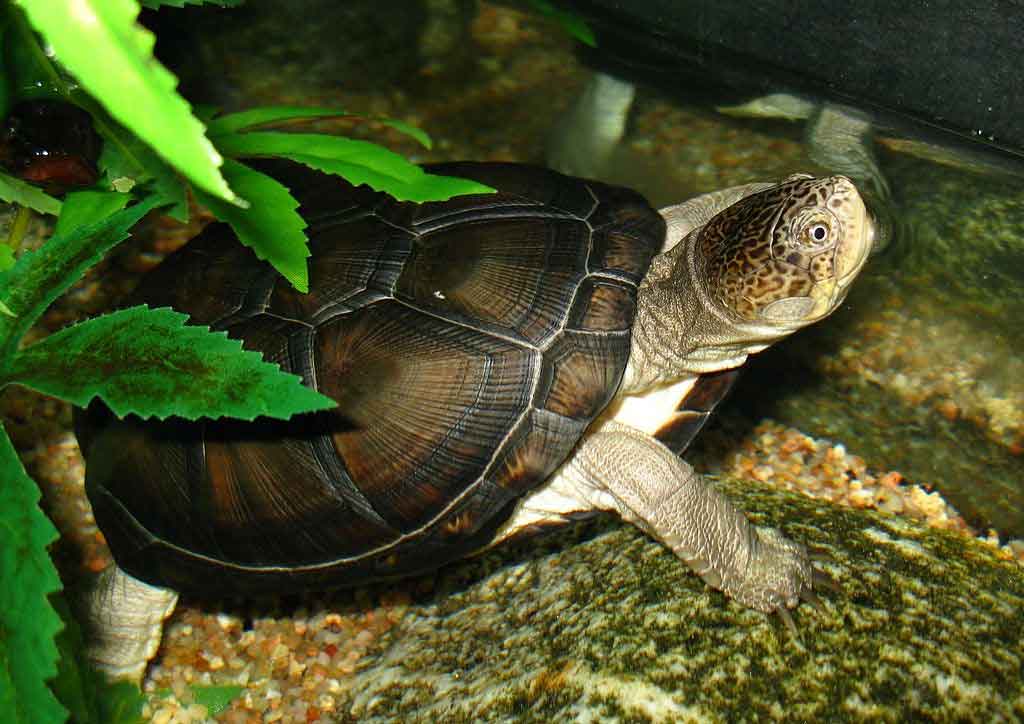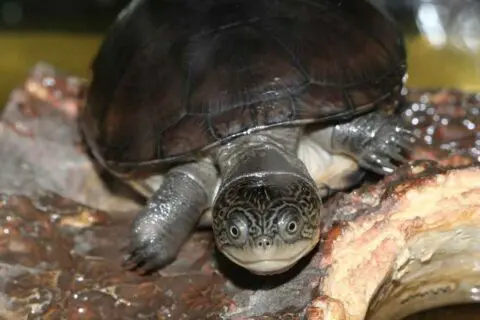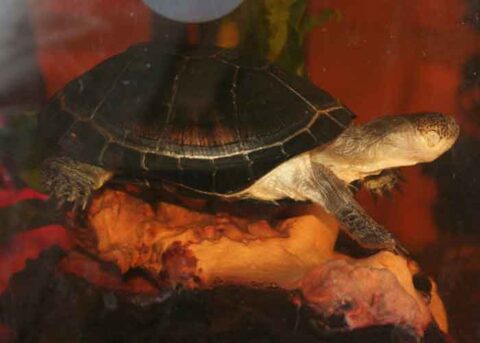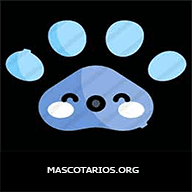
Content |
|---|
Origin / Distribution
The call Seychelles black terrapin, Seychelles mud turtle or Seychelles aquatic turtle was considered a species of turtle (Pelusios seychellensis) family Pelomedusidae, endemic to Seychelles.
But, genetic analysis of the lectotype has shown that this turtle was never a separate species and, in fact, It Pelusios castaneus.
The West African mud turtle (Pelusios castaneus) it is one of the most widespread turtle species in Africa. It is present practically throughout the Atlantic coast of the black continent: from southern Mauritania, Senegal, passing through Gambia, Guinea-Bissau, Guinea, Sierra Leone, Liberia, Ivory Coast, Ghana, Togo, Benin, Nigeria, Cameroon and as far north-west of the Central African Republic. It also, looking south from Cameroon, the species colonizes an area of Equatorial Guinea, Gabon, Congo, DR Congo and reaches the northernmost part of Angola.
The species is also found in São Tomé, an island off Gabon. There is a human population in the Caribbean, on the island of Guadeloupe, where it probably comes from the slaves who carried the animals as live food (the turtle is still eaten today, it will be discussed later). There is also said to be a feral population in Florida., these animals would have been abandoned by an animal trader.
Characteristics / Appearance

Large turtle, rather flat, with oval and elongated dorsal carapace, which has the largest width in the back area. Adults have a slightly separated vertebra at the front and a slightly separated vertebra toward the rear. Both vertebrae are wider than they are long.
The margin of the shell is smooth and not sawn. The dorsal carapace is mostly dark brown to black. The ventral shell forms a closed solid plate and is slightly narrower in the posterior region than in the anterior region.. The background color of the plastron is yellow in the center with a brown-black tint towards the edges. The skin is light gray to beige.
The head is mottled with a distinctive pattern, characteristic of each individual, as a fingerprint. On the chin there is 2 short, closed beards. The front legs also have scales and all the feet have strong claws..
Males have a shell length of about 20 cm.. Females can reach up to 38 cm of shell length, but they are usually much smaller (~ 25 cm of shell length). In addition to the usual elongated tail, the most conspicuous secondary sexual characteristic of males is a distinctly concave plastron.
Habitat
The West African mud turtle it is extremely adaptable and can be found in all types of waters. Pools, ponds, lakes, rivers… is at home everywhere. In much of its range, living waters dry up during 6-7 months per year, time that the P. castaneus passes buried in the substrate. But, there are also rainforest species that have water all year round.
The West African mud turtle nor is it very demanding in terms of food. Feeds on insects, snails, carrion, small fish, amphibians and, occasionally, fruits and seeds. The species is also very fertile. Large females can easily produce two clutches a year with up to 18 eggs.
Behavior
The West African mud turtle It is carnivorous and feeds on aquatic prey.. The feeding consists of five phases: preliminary fixation of the head on the dam, the adjustment of the head fixation, the final approach of the head, prey grip followed by handling and transport, and suction, which results in the ingestion after which the prey is swallowed. The final phase varies depending on whether the prey is fast, like a fish, or slow, as a gastropod mollusk.
Threats to the species
State of conservation ⓘ |
||
|---|---|---|
 Minor Concern ⓘ
(UICN)ⓘ
Minor Concern ⓘ
(UICN)ⓘ
| ||
Unfortunately, today one can hardly talk about turtles without talking about the threatened situation of the species. Given its huge distribution area and its great adaptability, the West African mud turtle shouldn't be endangered. But, natural populations in most of its range have not been studied scientifically. Hardly any funds are allocated to field research, so hardly anything is known about the evolution of the population.
Scientists from Nigeria follow a very interesting approach: regularly visit the markets where the “bushmeat”. This includes, of course, these species of turtles. Unfortunately, during these visits it was necessary to verify that the populations of turtles of the genus Kinixys are in clear decline. But, the West African mud turtle not yet considered endangered and not subject to international trade restrictions.
The "West African mud turtle" in captivity
Aquaterrarium
Due to the climatic conditions of the country of origin, the size of the animals (up to a maximum of 38 cm of shell length!) and its activity, the West African mud turtle needs large, air-conditioned aquaterrariums with plenty of space to swim all year round.
The water section for an adult animal must have a minimum size of 150 x 60 cm and a water depth of at least 50 cm.. In addition to the free swimming areas, the water part must be structured with stones, branches and plants to offer animals stimulation and variety.
In addition to a sunny area on land and the mandatory egg-laying area when having females, the facility must also offer shallow water areas. Floating plants on the surface of the water offer protection and invite you to rest on the surface.
Although the West African mud turtle does not sunbathe as extensively as, for example, the “North American ornamental turtles”, the sunbathing area is frequently visited and used, so it must always be available.
Equipment

Standard tank technical equipment includes fluorescent daylight tubes, heat radiators over the shallow water/stunning area and, occasionally, on the egg-laying area, external filter, heater, thermometer and timer. As an alternative, instead of daylight fluorescent tubes and heat radiators, powerful HQI radiators can be installed to illuminate a part of the tank and generate sufficient temperatures locally in the sunbathing area.
As for water and air temperatures, you must follow the climatic guidelines in the seasonal change of the country of origin (West Africa). In tropical areas there is also a day/night variation, as well as seasonal differences, although less pronounced than here.
A rough guideline is a water temperature of 25-28° and a local air temperature of up to 40° in the sun. You can get a night setback by turning off the heating at night.
Summer lethargy does not necessarily have to be applied in captivity. But, animals should not be kept at constantly high temperatures throughout the year. For a few weeks, or even months, should simulate colder phases at a water temperature of about 20-24°. Transitions should be gradual and the temperature should be increased or decreased over a few days.
Food
The West African mud turtle does not have high food requirements. Eat anything offered to you as animal feed. The spectrum ranges from dry food (Lundi pellets, colored koi pellets, Sera Raffy P pellets, gammarus and dried fish, brekkies), to fish (various freshwater fish, smelts, pollock, etc.), mussel meat, common earthworm, heart of veal and mice (little mice and jumpers).
In addition to the aquatic plants present in the tank (Juncos, duckweeds, horn, duckweed, water hyacinth, water cabbage), green food is regularly offered (dandelion, Canons, oak leaf lettuce, Cucumber, zucchini and tomatoes).
Reproduction
Like almost all male turtles, the males of the West African mud turtle are always willing to mate, but their courtship behavior is more moderate and less aggressive than that of many other species. However, the sexes must be kept separate for a part of the year for the females to rest.
The courtship exhibition of this species can last several hours. First the male tries head and neck movements to attract attention. If the female is interested and does not avoid it, the male seeks direct body contact, pushing your nose. If the female then indicates that she is willing to mate by brief choppy head movements, the male rides. At no time does it try to bite the female.
Adult females need a place of oviposition of at least 60 x 50 x 50, since they bury their laying of up to 22-32 eggs very deep in the sand.
Hibernation
The West African mud turtle does not hibernate due to the climatic demands of the countries of origin (West Africa). However, day/night latency, as well as seasonal differences, must be simulated with technical aids.
Buy one "West African mud turtle"
All turtles pelomedus are not internationally protected species, so wild-caught specimens remain regularly available in the reptile trade. Wild catches are often surprisingly hard, weakened by long transport and numerous intermediate stops. If you have the opportunity, do not hesitate to buy european pups. The young are much more stable and less susceptible to diseases.
The price of a "West African mud turtle" at the exotic animal market, bred in captivity, ranges between 25 – 50 EUR.
Videos "West African mud turtle"
|
|
|
|---|
Alternative names:
1. West African mud turtle, West African side-necked turtle or swamp terrapin (English).
2. Péluse de Schweigger (French).
3. Westafrikanische Klappbrust-Pelomedusenschildkröte, Westafrikanische Seitenhalsschildkröte oder Sumpfschildkröte bekannt (German).
4. Tartaruga de lama da África Ocidental, Tartaruga de pescoço lateral da África Ocidental ou pântano (Portuguese).
5. Tortuga del barro de África Occidental, Tortuga de caja africana (español).
